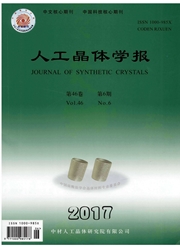

 中文摘要:
中文摘要:
采用简单的水解法在常温下制备出了BiOCl光催化剂,并对其进行了X-射线衍射(XRD),紫外可见漫反射光谱(DRS),透射电子显微镜(TEM),X射线光电子能谱(XPS)表征。考察了6种常见的无机阳离子(Ca^2+、Mg^2+、Zn^2+、Cu^2+、Al^2+、Fe^2+)对BiOCl光催化降解罗丹明B(RhB)活性的影响,并以Mg^2+和Fe^3+为具体研究对象,探讨了离子浓度对BiOCl光催化活性的影响及其影响机制。结果表明:Cu^2+和Mg^2+抑制了RhB的降解;Ca^2+和Zn^2+对RhB的降解几乎无影响;而Al^3+和Fe^3+促进了RhB的降解;Mg^2+的抑制作用是因为Mg^2+抑制了·O_2^-的形成,而Fe^3+的促进作用来源于RhB的吸附随Fe^3+加入而增加,并引起光催化活性的上升。
 英文摘要:
英文摘要:
BiOCl photocatalyst was successfully prepared via a facile hydrolysis method at room temperature. The as-synthesized product was characterized by X-ray diffraction (XRD), UV-vis diffuse reflectance spectra (DRS), transmission electron microscopy (TEM) and X-ray photoemission spectroscopy (XPS). The effect of inorganic cations (Ca^2+, Mg^2+, Zn^2+, Cu^2+, Al^3+, and Fe^3+) on the degradation of Rhodamine B was investigated. Then Mg^2+ and Fe^3+ were taken as major research objects to examine the effect of the concentration and the influence mechanism in detail. Results indicate that Cu^2+ and Mg^2+ could inhibit the RhB degradation, Ca^2+ and Zn^2+ had little effect on photocatalysis reaction, in contrast, Al^3+ and Fe^3+ could significantly improve the photodegradation of RhB. The inhibitory mechanism of Mg^2+ was involved the suppressed formation of ·O_2^- , while the presence of Fe^3+ could increase the adsorption of RhB, which enhanced the photocatalytic activity of BiOCl catalyst.
 同期刊论文项目
同期刊论文项目
 同项目期刊论文
同项目期刊论文
 Electronic structures and optical properties of transition metals (Fe, Co, Ni, Zn) doped rutile TiO2
Electronic structures and optical properties of transition metals (Fe, Co, Ni, Zn) doped rutile TiO2 Preparation and photocatalytic properties of ilmenite NiTiO3 powders for degradation of humic acid i
Preparation and photocatalytic properties of ilmenite NiTiO3 powders for degradation of humic acid i A dual chelating sol-gel synthesis of BaTiO3 nanoparticles with effective photocatalytic activity fo
A dual chelating sol-gel synthesis of BaTiO3 nanoparticles with effective photocatalytic activity fo First-principles investigation of impurity concentration influence on bonding behavior, electronic s
First-principles investigation of impurity concentration influence on bonding behavior, electronic s First-principles study on the structural, electronic and optical properties of BiOX (X=Cl, Br, I) cr
First-principles study on the structural, electronic and optical properties of BiOX (X=Cl, Br, I) cr Low temperature one-step synthesis of rutile TiO2/BiOCl composites with enhanced photocatalytic acti
Low temperature one-step synthesis of rutile TiO2/BiOCl composites with enhanced photocatalytic acti Facile preparation of Sn-doped BiOCl photocatalyst with enhanced photocatalytic activity for benzoic
Facile preparation of Sn-doped BiOCl photocatalyst with enhanced photocatalytic activity for benzoic DFT+U predictions: The effect of oxygen vacancy on the structural, electronic and photocatalytic pro
DFT+U predictions: The effect of oxygen vacancy on the structural, electronic and photocatalytic pro Synthesis of BiOCl photocatalyst by a low-cost, simple hydrolytic technique and its excellent photoc
Synthesis of BiOCl photocatalyst by a low-cost, simple hydrolytic technique and its excellent photoc Effect of light response on the photocatalytic activity of BiOCl (x) Br1-x in the removal of Rhodami
Effect of light response on the photocatalytic activity of BiOCl (x) Br1-x in the removal of Rhodami One-step synthesis of porous BiOBrfilm and Bi nanopowder simultaneously from Bi plate via electroche
One-step synthesis of porous BiOBrfilm and Bi nanopowder simultaneously from Bi plate via electroche Photocatalytic degradation of carbamazepine using hierarchical BiOClmicrospheres: Some key operating
Photocatalytic degradation of carbamazepine using hierarchical BiOClmicrospheres: Some key operating Effect of chlorine ion on the crystalline and photocatalytic activityof BiOCl for the degradation of
Effect of chlorine ion on the crystalline and photocatalytic activityof BiOCl for the degradation of An in vitro study on the cytotoxicity of bismuth oxychloride nanosheets in human HaCaT keratinocytes
An in vitro study on the cytotoxicity of bismuth oxychloride nanosheets in human HaCaT keratinocytes Rapid synthesis of hierarchical BiOCl microspheres for efficient photocatalytic degradation of carba
Rapid synthesis of hierarchical BiOCl microspheres for efficient photocatalytic degradation of carba A BiPO4/BiOCl heterojunction photocatalyst with enhanced electron-hole separation and excellent phot
A BiPO4/BiOCl heterojunction photocatalyst with enhanced electron-hole separation and excellent phot A facile approach for the tunable fabrication of BiOBr photocatalysts with high activity and stabili
A facile approach for the tunable fabrication of BiOBr photocatalysts with high activity and stabili One-pot hydrothermal synthesis of a novel BiPO4/BiOBrcomposite with enhanced visible light photocata
One-pot hydrothermal synthesis of a novel BiPO4/BiOBrcomposite with enhanced visible light photocata Comparative toxicities of bismuth oxybromide and titanium dioxideexposure on human skin keratinocyte
Comparative toxicities of bismuth oxybromide and titanium dioxideexposure on human skin keratinocyte Double Br sources fabrication and photocatalytic property of p-n junction BiOBr/ZnO composites for p
Double Br sources fabrication and photocatalytic property of p-n junction BiOBr/ZnO composites for p Effect of chlorine ion on the crystalline and photocatalytic activity of BiOCl for the degradation o
Effect of chlorine ion on the crystalline and photocatalytic activity of BiOCl for the degradation o RhB-sensitized effect on the enhancement of photocatalytic activity of BiOCl toward bisphenol-A unde
RhB-sensitized effect on the enhancement of photocatalytic activity of BiOCl toward bisphenol-A unde Regeneration of novel visible-light-driven Ag/Ag3PO4@C3N4 hybrid materials and their high photocatal
Regeneration of novel visible-light-driven Ag/Ag3PO4@C3N4 hybrid materials and their high photocatal Simple hydrolysis-photodeposition route to synthesize Ag/BiOCl0.5Br0.5 composites with highly enhanc
Simple hydrolysis-photodeposition route to synthesize Ag/BiOCl0.5Br0.5 composites with highly enhanc A facile approach for the tunable fabrication of BiOBr photocatalystswith high activity and stabilit
A facile approach for the tunable fabrication of BiOBr photocatalystswith high activity and stabilit 期刊信息
期刊信息
